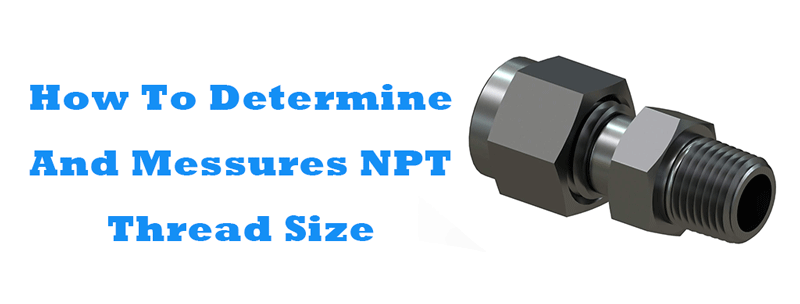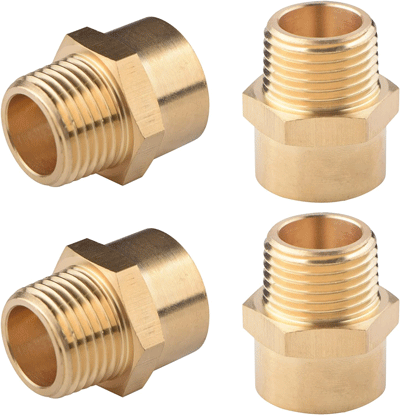 When it comes to working with pipes and fittings, understanding thread sizes is crucial. NPT (National Pipe Thread) is a common thread type used in plumbing and industrial applications in the United States. Determining and measuring NPT thread size can sometimes be confusing, but with the right information and tools, it becomes a straightforward process. In this guide, we will explore what NPT thread size is, how to determine pipe thread size, and specifically, what thread sizes like 1/2 NPT, 1/4 NPT, and 1/8 NPT represent.
When it comes to working with pipes and fittings, understanding thread sizes is crucial. NPT (National Pipe Thread) is a common thread type used in plumbing and industrial applications in the United States. Determining and measuring NPT thread size can sometimes be confusing, but with the right information and tools, it becomes a straightforward process. In this guide, we will explore what NPT thread size is, how to determine pipe thread size, and specifically, what thread sizes like 1/2 NPT, 1/4 NPT, and 1/8 NPT represent.
What is NPT Thread Size?

NPT, or National Pipe Thread, is a standardized thread type used for joining and sealing pipes and fittings. It is widely used in the United States for a variety of applications, including plumbing, gas lines, and hydraulic systems. NPT threads are tapered, which means they gradually become narrower toward the end of the pipe. This tapering design is what helps create a tight seal when two NPT components are connected, preventing leaks.
NPT threads come in different sizes, and the size is typically specified as a fraction, followed by the number of threads per inch. For example, 1/2 NPT means the thread size is 1/2 inch in diameter, with a specific number of threads per inch. To determine and measure NPT thread size accurately, you’ll need a few simple tools and a good eye for detail.
How to Determine Pipe Thread Size
- Thread Pitch Gauge: To measure NPT thread size, the first tool you’ll need is a thread pitch gauge. This tool helps you determine the number of threads per inch accurately. Start by placing the gauge on the threads and matching them with the pitch on the gauge. Ensure a snug fit for the most accurate measurement.
- Thread Diameter Measurement: The next step is to measure the diameter of the threaded portion of the pipe or fitting. Use a caliper or a pipe thread ruler to measure the outside diameter. Keep in mind that NPT threads are tapered, so you should measure the larger end of the threaded section.
- Count the Threads: Count the number of threads per inch on the threaded portion of your pipe or fitting. This count is critical in determining the NPT size.
- Use a Reference Table: Once you have the thread pitch and diameter measurements, you can refer to a reference table to determine the NPT size. These tables are widely available online or in plumbing and engineering reference books.
- Consider Thread Type: It’s essential to note that NPT threads come in different types, including NPTF (National Pipe Taper Fuel) and NPTL (National Pipe Taper, Dryseal). These variations have specific applications and sealing requirements. Ensure you identify the correct thread type in addition to the size.
Common NPT Thread Sizes
Now, let’s explore the specific thread sizes you mentioned:
1/2 NPT
1/2 NPT refers to a thread size with a 1/2 inch outside diameter and a specific number of threads per inch. In the case of 1/2 NPT, there are 14 threads per inch. This size is commonly used in various plumbing and industrial applications, including connecting pipes and fittings in water and gas systems.
1/4 NPT
1/4 NPT represents a thread size with a 1/4 inch outside diameter and, like 1/2 NPT, 14 threads per inch. It’s a smaller and less common NPT size, often used in situations where a smaller pipe diameter is sufficient, such as in some air or hydraulic systems.
1/8 NPT
1/8 NPT is even smaller, with a 1/8 inch outside diameter and 27 threads per inch. This fine thread size is used in specialized applications where precision and a tight seal are necessary. You might find 1/8 NPT threads in instruments, gauges, and other delicate equipment.
In all these cases, the thread size and type are crucial to ensure a proper fit and leak-free connection. Remember to measure carefully and consult reference materials to confirm the size and type of NPT threads you are working with.
Conclusion
Understanding and measuring NPT thread sizes is a fundamental skill when working with pipes and fittings. NPT threads are widely used in the United States, and their tapered design ensures a secure seal when properly connected. To determine and measure NPT thread size, use tools like a thread pitch gauge and caliper to obtain accurate measurements of thread pitch and diameter. Then, consult reference tables to identify the NPT size.
Common NPT thread sizes like 1/2 NPT, 1/4 NPT, and 1/8 NPT have specific measurements and are used in various applications. By following the steps outlined in this guide, you can confidently identify and work with NPT threads, ensuring that your plumbing and industrial projects are successful and leak-free.
 WOWOW Faucets
WOWOW Faucets






您好!Please sign in